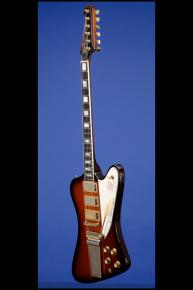An Original "Reverse" Firebird Vll
This early 1964 'reverse' Firebird Vll weighs just 9.00 lbs. and has a nice nut width of just under 1 11/16 inches and a standard Gibson scale length of 24 3/4 inches. Solid mahogany body, one-piece mahogany neck with a medium profile, and bound ebony fretboard with 22 thin flat frets and inlaid pearl block position markers. Headstock with gold-painted "Gibson" logo on black plastic truss-rod cover. Individual Gibson Banjo-style tuners with rearwards tulip-shaped metal buttons. Serial number “171661” stamped in black on back of headstock. Three patent-number mini-humbuckers, each with a small rectangular black label lettered in gold "Patent No. / 2,737,842" on the underside. Three-layer (white/black/white) plastic pickguard with eight screws and a "Firebird" emblem painted on in red. Four controls (two volume, two tone) on lower treble bout, plus three-way selector switch on pickguard. The potentiometers are stamped "137 64 0X (last digit on all four pots obscured by the solder) which corresponds with CTS, January through March 1964. Gold plastic bell-shaped knobs with metal tops. ABR-1 Tune-O-Matic 'retainer' bridge with metal saddles, Gibson Deluxe Vibrola tailpiece with walrus tooth handle on tubular arm. All parts gold-plated. There is an area of belt-buckle wear on the back of the body (approximately 1 1/2 inches x 1 1/2 inches). The lower tip of the pickguard has broken off at the screw-hole and the upper tip of the trussrod cover has suffered the same fate. There are a few small edge marks and some minor tarnishing to the gold hardware - taking all that into account this guitar is in excellent plus plus (8.75+) condition. Original Gibson black hardshell case with orange plush lining (8.75).
The Firebird Vll was the Firebird equivalent of the SG Custom and also the rarest of the series.
"Announced in Spring 1963, the original Firebird series was conceived as an attempt to produce less conventional electrics likely to appeal to Fender players. Four different models, identified by odd Roman numerals, were marketed simultaneously... The four models produced between 1963 and 1965 (a.k.a. the 'reverse' Firebirds) share the same body specifications and differ only in fretboard style, electronics and hardware... The original Firebird electrics are primarily characterized by: - a neck-through-body construction; - a reverse body shape with extended lower horn; - a reverse peghead with the treble E tuner nearest to the nut; - banjo-style tuners with rearwards buttons; - and they are all equipped with mini-humbuckers built without adjustable polepieces. The early samples are characterized by a 2-piece full length neck and a convex heel where the neck blends into the body. By late 1963, production models were released with a stronger 9-piece lamination and a smaller squared-off heel. A painted-on red Firebird emblem was also added on the white pickguard... According to factory records, the earliest production models were registered in October 1963 with serial numbers in the 131,000s… The top-end FB Vll was released with the refined appointments of the contemporary SG/LP Custom. Compared to the other three models in the series, it is thus characterized by: - a bound ebony fingerboard with pearl block inlays - three pickups - gold-plated metal parts… The original Firebird series remained in production for less than two years between Fall 1963 and mid-65, and the shipping totals for 1965 include both 'reverse' and 'non-reverse' instruments. It is therefore misleading to add up the figures from 1963-64-65 to assess the total number of reverse-bodied Firebirds produced during this period. A more pertinent estimate would suggest the following quantities: about ,000 FB l, 2,000 FB lll, 700 FB V and 250 FB Vll with 1964 clearly being the most abundant year." (A.R. Duchossoir, Gibson Electrics -- The Classic Years, pp. 198-199).
"New automobile designs out of Detroit had caught McCarty's eye, and he hired the man responsible, Ray Dietrich, to draw up some guitars. Dietrich sketched a series of models, and one was chosen. The new guitar bucked tradition with a treble-side horn longer than the bass horn -- the reverse of conventional style. The headstock, too, was reversed, with all the tuners on the treble side. To avoid an awkward tuning procedure, banjo-style tuners went straight out the back of the headstock. The neck went all the way through the body. The pickups were unique: mini-humbuckers with no visible polepieces. The new creations were dubbed Firebirds, and a flock of four models debuted in 1963. A new set of custom color finishes was introduced just for them" (Walter Carter, Gibson Guitars: 100 Years of an American Icon, p. 237).
Translate:











